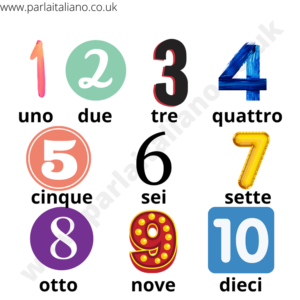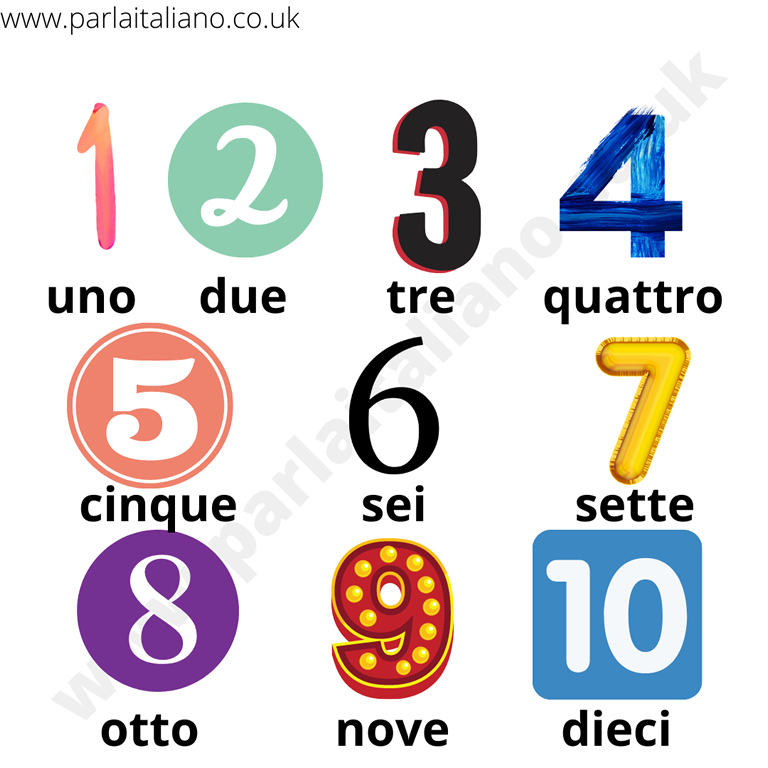One of the first items on the list if you wish to learn Italian is the numbers. These are mostly easy to grasp, have a predictable pattern and, in no time, you will be able to count from 1 to a trillion.
In this blog you will learn:
- Italian numbers from 1 to a million and beyond
- how to write and how to pronounce the numbers in Italian
- the rules of exceptions of Italian numbers
- a few tricks to make them easy to remember
- the simple and predictable pattern of Italian numbers
- the Italian (European) number formatting
- interesting idioms about numbers
- and you will also get some practice
The numbers 1 to 10
Language learning would not get off on the right foot, without learning the 1, 2, 3. So lets start with learning the first basic set from 1 to 10 and see how they are written.

However, it is important to learn how to pronounce them. Take a look at this short video. After the first listening, you can play the video again, and pronounce the number in the pause between each of them. Practise makes perfect!
The number 0
Also note, that the number 0 is ‘zero’ and the z is pronounced /ds/ so the sounds is: /dsee-roh/
So now that you have learned the first ten numbers, let’s have a little practice.
Practice 1:
What is the result of:
uno + tre =
quattro + cinque =
nove + uno =
sette – due =
sei + due =
uno + cinque =
dieci – sette =
Write the answers in letters and then see them at the bottom of the blog.
The numbers 11 to 20
After mastering the first set of numbers, you are now ready to learn the numbers from 11 to 20. Here is a short video to hear how to pronounce and write them:
As you can see, you need to learn these numbers by heart, however, there is a pattern with these numbers. For example, the numbers from 11 to 16 start with the second digit and end in ‘dici’ as in undici, dodici, tredici, and so on.
I’d like to add a quick note about the number 15. Unlike the others, 15 is slightly different and for that it is usually less memorable. A quick memory trick is to think of the word ‘queen’ and imagine the number with a crown, as it sounds a bit like it: 15 = quindici.
Unlike the others, the numbers from 17 to 19 take the opposite pattern, they start with ‘dici’ and finish with the second digit, for example: diciassette, diciotto, diciannove.
So now that you have mastered the numbers up to 20, let’s have a little practice.
Practice 2:
What is the result of (write the answers in letters and check them at the end of the blog):
uno + tredici =
quattro + undici =
sei + dodici =
quattordici + due =
diciannove – cinque =
venti – otto =
sedici – quindici =
diciassette – otto =
diciannove – diciotto =
The numbers 20 to 100
Thirdly, even if you must learn the first 20 numbers, the rest are pretty easy. They work like the number in English so you simply combine the two digit together. For example for 22 you simply put together 20 (venti) and 2 (due) to form ventidue. If you need the number 35 again you combine 30 (trenta) and 5 (cinque) to form trentacinque. The two numbers become one word so no spaces or hyphens required.
So now, it is time to see and hear the tens (le decine) to help you combine these with the previous set:
Exceptions
There are two exceptions when putting numbers together and this is when the unit starts with a vowel. This is the case with uno (1) and otto (8).
In this case there is an elision of the previous word. For example to form 21 you need venti (20) and uno (1), so venti loses the vowel at the end and you will get ventuno. 28 is ventotto, 31 is trentuno, 38 is trentotto, and so on.
The accent
In Italian the graphical accent is required only in very few cases. One of these is when a number greater than 20 ends with 3. In this case you have to write the 3 (tre) with the accent which is an acute accent. For example: 23 = ventitré, 33 = trentatré, 43 = quarantatré, etc.
Practice 3:
Can you write the result of these addition and subtractions in letters? Then check if you are correct at the end of the blog:
venti + nove =
ottanta + otto =
trentadue + ventisei =
novantaquattro – trentatré =
tredici + venti =
Number 100 to a 1000
To conclude this first part, you should now be able to count from 0 to 100. Going from 100 to 900 is fairly simple. As you already know from the previous video, 100 is cento. To form the other hundreds simply add the unit to cento, for example 200 = duecento, 300 = trecento, 400 = quattrocento, and so on. Until you get to 1000, which is mille.
To count in thousands is also very simple, you start with mille (1000) and then you use the basic digit adding mila at the end. 2000 is duemila, 3000 is tremila, 4000 is quattromila, and so on.
However, please note that in Italian is not possible – as it is in English – to say 11 hundred but you must say millecento (1100), duemiladuecento (2200), etc.
The very large numbers
Before we conclude, here is our final list of the very large numbers. See how they are written and play the video for hearing their pronunciation.
Number formatting in Italian
Last but not least, a note about commas and full stops when writing your numbers in digits.
In Italy, as it is the case in most of the European countries, the full stop and the comma are used in the opposite way as the British and Americans do. So the comma is used as a decimal marker and the full stop is used to separate groups of three digits in larger numbers.
So for example in Italian, one point five is written like this: 1,5 and a thousand is written like this: 1.000. Can be confusing if you don’t know it and it takes a bit to get used to it.
Essential vocabulary:
Numeri cardinali
Numeri ordinali
Numeri primi
Numeri dispari
Numeri pari
Numeri decimali
Common idioms with numbers
1. Farsi in quattro (per qualcuno)
This means to work hard to help someone, to do all that you can to help someone.
Example: Antonella si è fatta in quattro per aiutare il fratello.
2. Su due piedi
This means immediately, without preparation. At once or on the spot.
Example: Non so rispondere alla tua domanda su due piedi, ma posso fare un po’ di ricerca.
3. Sudare sette camicie
This means to work really hard for something. To go through a great deal of trouble for something or someone.
Example: Ho sudato sette camicie per insegnare i pronomi combinati.
For more idioms, please follow me on instagram, where I publish daily content for Italian students:
Parla Italiano’s school on instagram
Answers to practice 1:
quattro/nove/dieci/cinque/otto/sei/tre
Answers to practice 2:
quattordici/quindici/diciotto/sedici/quattordici/dodici/uno/nove/uno
Answers to practice 3:
Ventinove/ottantotto/cinquantotto/sessantuno/trentatré







